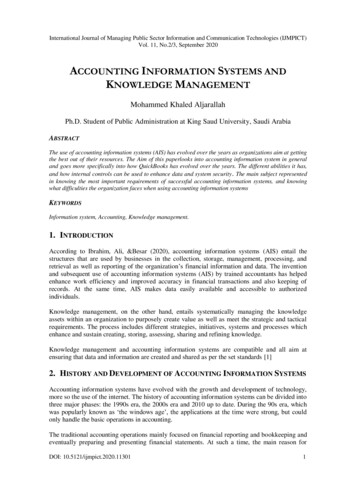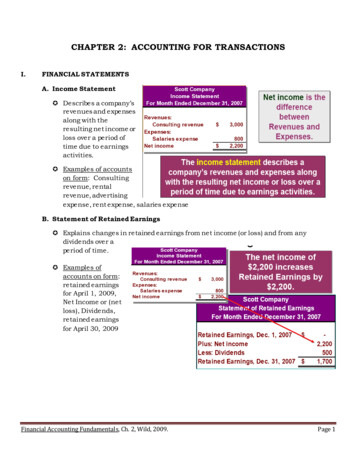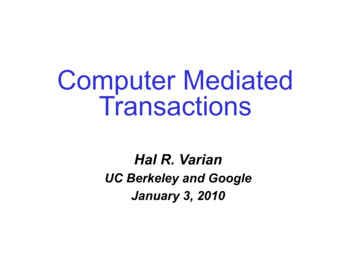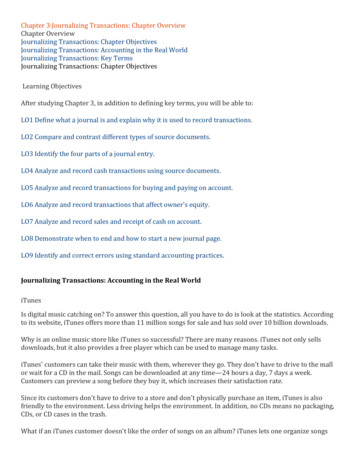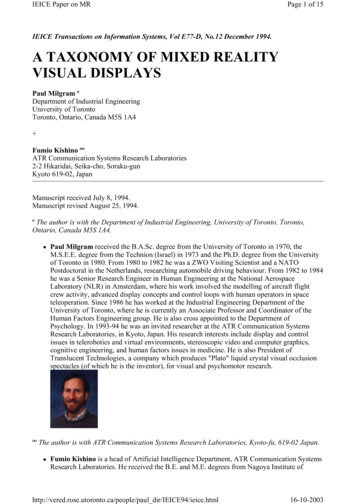
Transcription
IEICE Paper on MRPage 1 of 15IEICE Transactions on Information Systems, Vol E77-D, No.12 December 1994.A TAXONOMY OF MIXED REALITYVISUAL DISPLAYSPaul Milgram ºDepartment of Industrial EngineeringUniversity of TorontoToronto, Ontario, Canada M5S 1A4 Fumio Kishino ººATR Communication Systems Research Laboratories2-2 Hikaridai, Seika-cho, Soraku-gunKyoto 619-02, JapanManuscript received July 8, 1994.Manuscript revised August 25, 1994.º The author is with the Department of Industrial Engineering, University of Toronto, Toronto,Ontario, Canada M5S 1A4.zPaul Milgram received the B.A.Sc. degree from the University of Toronto in 1970, theM.S.E.E. degree from the Technion (Israel) in 1973 and the Ph.D. degree from the Universityof Toronto in 1980. From 1980 to 1982 he was a ZWO Visiting Scientist and a NATOPostdoctoral in the Netherlands, researching automobile driving behaviour. From 1982 to 1984he was a Senior Research Engineer in Human Engineering at the National AerospaceLaboratory (NLR) in Amsterdam, where his work involved the modelling of aircraft flightcrew activity, advanced display concepts and control loops with human operators in spaceteleoperation. Since 1986 he has worked at the Industrial Engineering Department of theUniversity of Toronto, where he is currently an Associate Professor and Coordinator of theHuman Factors Engineering group. He is also cross appointed to the Department ofPsychology. In 1993-94 he was an invited researcher at the ATR Communication SystemsResearch Laboratories, in Kyoto, Japan. His research interests include display and controlissues in telerobotics and virtual environments, stereoscopic video and computer graphics,cognitive engineering, and human factors issues in medicine. He is also President ofTranslucent Technologies, a company which produces "Plato" liquid crystal visual occlusionspectacles (of which he is the inventor), for visual and psychomotor research.ºº The author is with ATR Communication Systems Research Laboratories, Kyoto-fu, 619-02 Japan.zFumio Kishino is a head of Artificial Intelligence Department, ATR Communication SystemsResearch Laboratories. He received the B.E. and M.E. degrees from Nagoya Institute ofhttp://vered.rose.utoronto.ca/people/paul dir/IEICE94/ieice.html16-10-2003
IEICE Paper on MRPage 2 of 15Technology, Nagoya, Japan, in 1969 and 1971, respectively. In 1971, he joined the ElectricalCommunication Laboratories, Nippon Telegraph and Telephone Corporation, where he wasinvolved in work on research and development of image processing and visual communicationsystems. In mid-1989, he joined ATR Communication Systems Research Laboratories. Hisresearch interests include 3D visual communication and image processing. He is a member ofIEEE and ITEJ.SummaryThis paper focuses on Mixed Reality (MR) visual displays, a particular subset of Virtual Reality(VR) related technologies that involve the merging of real and virtual worlds somewhere along the"virtuality continuum" which connects completely real environments to completely virtual ones.Probably the best known of these is Augmented Reality (AR), which refers to all cases in which thedisplay of an otherwise real environment is augmented by means of virtual (computer graphic)objects. The converse case on the virtuality continuum is therefore Augmented Virtuality (AV). Sixclasses of hybrid MR display environments are identified. However, an attempt to distinguish theseclasses on the basis of whether they are primarily video or computer graphics based, whether the realworld is viewed directly or via some electronic display medium, whether the viewer is intended tofeel part of the world or on the outside looking in, and whether or not the scale of the display isintended to map orthoscopically onto the real world leads to quite different groupings among the sixidentified classes, thereby demonstrating the need for an efficient taxonomy, or classificationframework, according to which essential differences can be identified. The 'obvious' distinctionbetween the terms "real" and "virtual" is shown to have a number of different aspects, depending onwhether one is dealing with real or virtual objects, real or virtual images, and direct or non-directviewing of these. An (approximately) three dimensional taxonomy is proposed, comprising thefollowing dimensions: Extent of World Knowledge ("how much do we know about the world beingdisplayed?"), Reproduction Fidelity ("how 'realistically' are we able to display it?"), and Extent ofPresence Metaphor ("what is the extent of the illusion that the observer is present within thatworld?").key words: virtual reality (VR), augmented reality (AR), mixed reality (MR)1. Introduction -- Mixed RealityThe next generation telecommunication environment is envisaged to be one which will provide an"ideal virtual space with [sufficient] reality essential for communication"º . Our objective in thispaper is to examine this concept, of having both "virtual space" on the one hand and "reality" on theother available within the same visual display environment.The conventionally held view of a Virtual Reality (VR) environment is one in which the participantobserver is totally immersed in, and able to interact with, a completely synthetic world. Such a worldmay mimic the properties of some real-world environments, either existing or fictional; however, itcan also exceed the bounds of physical reality by creating a world in which the physical lawsordinarily governing space, time, mechanics, material properties, etc. no longer hold. What may beoverlooked in this view, however, is that the VR label is also frequently used in association with avariety of other environments, to which total immersion and complete synthesis do not necessarilypertain, but which fall somewhere along a virtuality continuum. In this paper we focus on a particularsubclass of VR related technologies that involve the merging of real and virtual worlds, which werefer to generically as Mixed Reality (MR). Our objective is to formulate a taxonomy of the variousways in which the "virtual" and "real" aspects of MR environments can be realised. The perceivedneed to do this arises out of our own experiences with this class of environments, with respect towhich parallel problems of inexact terminologies and unclear conceptual boundaries appear to existhttp://vered.rose.utoronto.ca/people/paul dir/IEICE94/ieice.html16-10-2003
IEICE Paper on MRPage 3 of 15among researchers n the field.The concept of a "virtuality continuum" relates to the mixture of classes of objects presented in anyparticular display situation, as illustrated in Figure 1, where real environments, are shown at one endof the continuum, and virtual environments, at the opposite extremum. The former case, at the left,defines environments consisting solely of real objects (defined below), and includes for examplewhat is observed via a conventional video display of a real-world scene. An additional exampleincludes direct viewing of the same real scene, but not via any particular electronic display system.The latter case, at the right, defines environments consisting solely of virtual objects (definedbelow), an example of which would be a conventional computer graphic simulation. As indicated inthe figure, the most straightforward way to view a Mixed Reality environment, therefore, is one inwhich real world and virtual world objects are presented together within a single display, that is,anywhere between the extrema of the virtuality continuum.Figure 1: Simplified representation of a "virtuality continuum".Although the term "Mixed Reality" is not (yet) well known, several classes of existing hybrid displayenvironments can be found, which could reasonably be considered to constitute MR interfacesaccording to our definition:zzzzzz1. Monitor based (non-immersive) video displays – i.e. "window-on-the-world" (WoW)displays – upon which computer generated images are electronically or digitally overlaid (e.g.Metzger, 1993; Milgram et al, 1991; Rosenberg, 1993; Tani et al, 1992). Although thetechnology for accomplishing such combinations has been around for some time, most notablyby means of chroma-keying, practical considerations compel us to be interested particularly insystems in which this is done stereoscopically (e.g. Drascic et al, 1993; Lion et al, 1993).2. Video displays as in Class 1, but using immersive head-mounted displays (HMD's), ratherthan WoW monitors.3. HMD's equipped with a see-through capability, with which computer generated graphicscan be optically superimposed, using half-silvered mirrors, onto directly viewed real-worldscenes (e.g. Bajura et al, 1992; Caudell & Mizell, 1992; Ellis & Bucher, 1992; Feiner et al,1993a,b; Janin et al, 1993).4. Same as 3, but using video, rather than optical, viewing of the "outside" world. Thedifference between Classes 2 and 4 is that with 4 the displayed world should correspondorthoscopically with the immediate outside real world, thereby creating a "video see-through"system (e.g. Edwards et al, 1993; Fuchs et al, 1993), analogous with the optical see-through ofoption 3.5. Completely graphic display environments, either completely immersive, partially immersiveor otherwise, to which video "reality" is added (e.g. Metzger, 1993).6. Completely graphic but partially immersive environments (e.g. large screen displays) inwhich real physical objects in the user's environment play a role in (or interfere with) thecomputer generated scene, such as in reaching in and "grabbing" something with one's ownhand (e.g. Kaneko et al, 1993; Takemura & Kishino, 1992).http://vered.rose.utoronto.ca/people/paul dir/IEICE94/ieice.html16-10-2003
IEICE Paper on MRPage 4 of 15In addition, other more inclusive computer augmented environments have been developed in whichreal data are sensed and used to modify users' interactions with computer mediated worlds beyondconventional dedicated visual displays (e.g. Ishii et al, 1993; Krüger, 1993; Wellner, 1993; Mackayet al, 1993).As far as terminology goes, even though the term "Mixed Reality" is not in common use, the relatedterm "Augmented Reality" (AR) has in fact started to appear in the literature with increasingregularity. As an operational definition of Augmented Reality, we take the term to refer to any casein which an otherwise real environment is "augmented" by means of virtual (computer graphic)objects, as illustrated in Figure 1. The most prominent use of the term AR in the literature appears tobe limited, however, to the Class 3 types of displays outlined above (e.g. Feiner et al, 1993a,b;Caudell & Mizell, 1992; Janin et al, 1993). In the authors' own laboratories, on the other hand, wehave adopted this same term in reference to Class 1 displays as well (Drascic et al, 1993; Milgram etal, 1993), not for lack of a better name, but simply out of conviction that the term AugmentedReality is quite appropriate for describing the essence of computer graphic enhancement of videoimages of real scenes. This same logic extends to Class 2 and 4 displays also, of course.Class 5 displays pose a small terminology problem, since that which is being augmented is not somedirect representation of a real scene, but rather a virtual world, one that is generated primarily bycomputer. In keeping with the logic used above in support of the term Augmented Reality, wetherefore proffer the straightforward suggestion that such displays be termed "AugmentedVirtuality" (AV), as depicted in Figure 1ºº. Of course, as technology progresses, it may eventuallybecome less straightforward to perceive whether the primary world being experienced is in factpredominantly "real" or predominantly "virtual", which may ultimately weaken the case for use ofboth AR and AV terms, but should not affect the validity of the more general MR term to cover the"grey area" in the centre of the virtuality continuum.We note in addition that Class 6 displays go beyond Classes 1, 2, 4 and 5, in including directlyviewed real-world objects also. As discussed below, the experience of viewing one's own real handdirectly in front of one's self, for example, is quite distinct from viewing an image of the same realhand on a monitor, and the associated perceptual issues (not discussed in this paper) are also ratherdifferent. Finally, an interesting alternative solution to the terminology problem posed by Class 6 aswell as composite Class 5 AR/AV displays might be the term"Hybrid Reality" (HR)ººº, as a way ofencompassing the concept of blending many types of distinct display media.º Quoted from Call for Papers for this IEICE Transactions on Information Systems special issue onNetworked Reality.ºº Cohen (1993) has considered the same issue and proposed the term "Augmented Virtual Reality."As a means of maintaining a distinction betweem this class of displays and Augmented Reality,however, we find Cohen's terminology inadequate.ººº One potential piece of derivative jargon which immediately springs to mind as on extension of theproposed term "Hybrid Reality" is the possibility that (using a liberal dose of poetic licence) wemight refer to such displays as "Hyberspace"!2. The Need for a TaxonomyThe preceding discussion was intended to introduce the concept of Mixed Reality and some of itsvarious manifestations. All of the classes of displays listed above clearly share the common featureof juxtaposing "real" entities together with "virtual" ones; however, a quick review of the sampleclasses cited above reveals, among other things, the following important distinctions:zSome systems {1,2,4} are primarily video based and enhanced by computer graphics whereashttp://vered.rose.utoronto.ca/people/paul dir/IEICE94/ieice.html16-10-2003
IEICE Paper on MRPage 5 of 15others {5,6} are primarily computer graphic based and enhanced by video.zzzIn some systems {3,6} the real world is viewed directly (through air or glass), whereas inothers {1,2,4,5} real-world objects are scanned and then resynthesised on a display device(e.g. analogue or digital video).From the standpoint of the viewer relative to the world being viewed, some of the displays {1}are exocentric (WoW monitor based), whereas others {2,3,4,6} are egocentric (immersive).In some systems {3,4,6} it is imperative to maintain an accurate 1:1 orthoscopic mappingbetween the size and proportions of displayed images and the surrounding real-worldenvironment, whereas for others {1,2} scaling is less critical, or not important at all.Our point therefore is that, although the six classes of MR displays listed appear at first glance to bereasonably mutually delineated, the distinctions quickly become clouded when concepts such as real,virtual, direct view, egocentric, exocentric, orthoscopic, etc. are considered, especially in relation toimplementation and perceptual issues. The result is that the different classes of displays can begrouped differently depending on the particular issue of interest. Our purpose in this paper is topresent a taxonomy of those principal aspects of MR displays which subtend these practical issues.The purpose of a taxonomy is to present an ordered classification, according to which theoreticaldiscussions can be focused, developments evaluated, research conducted, and data meaningfullycompared. Four noteworthy taxonomies in the literature which are relevant to the one presented hereare summarised in the following.zzzzSheridan (1992) proposed an operational measure of presence for remotely performed tasks,based on three determinants: extent of sensory information, control of relation of sensors to theenvironment, and ability to modify the physical environment. He further proposed that suchtasks be assessed according to task difficulty and degree of automation.Zeltzer (1992) proposed a three dimensional taxonomy of graphic simulation systems, basedon the components autonomy, interaction and presence. His "AIP cube" is frequently cited as aframework for categorising virtual environments.Naimark (1991a,b) proposed a taxonomy for categorising different approaches to recordingand reproducing visual experience, leading to realspace imaging. These include: monoscopicimaging, stereoscopic imaging, multiscopic imaging, panoramics, surrogate travel and realtime imaging.Robinett (1992) proposed an extensive taxonomy for classifying different types oftechnologically mediated interactions, or synthetic experience, associated exclusively withHMD based systems. His taxonomy is essentially nine dimensional, encompassing causality,model source, time, space, superposition, display type, sensor type, action measurement typeand actuator type. In his paper a variety of well known VR-related systems are classifiedrelative to the proposed taxonomy.Although the present paper makes extensive use of ideas from Naimark and the others cited, it is inmany ways a response to Robinett's suggestion (Robinett, 1992, p. 230) that his taxonomy serve as"a starting point for discussion". It is important to point out the differences, however. Whereastechnologically mediated experience is indeed an important component of our taxonomy, we are notfocussing on the same question of how to classify different varieties of such interactions, as doesRobinett's classification scheme. Our taxonomy is motivated instead, perhaps more narrowly, by theneed to distinguish among the various technological requirements necessary for realising, andresearching, mixed reality displays, with no restrictions on whether the environment is l dir/IEICE94/ieice.html16-10-2003
IEICE Paper on MRPage 6 of 15immersive (HMD based) or not.It is important to point out that, although we focus in this paper exclusively on mixed reality visualdisplays, many of the concepts proposed here pertain as well to analogous issues associated withother display modalities. For example, for auditory displays, rather than isolating the participantfrom all sounds in the immediate environment, by means of a helmet and/or headset, computergenerated signals can instead be mixed with natural sounds from the immediate real environment.However, in order to "calibrate" an auditory augmented reality display accurately, it is necessarycarefully to align binaural auditory signals with synthetically spatialised sound sources. Such acapability is being developed by Cohen and his colleagues, for example (Cohen et al, 1993), byconvolving monaural signals with left/right pairs of directional transfer functions. Haptic displays(that is, information pertaining to sensations such as touch, pressure, etc.) are typically presented bymeans of some type of hand held master manipulator (e.g. Brooks, et al, 1990) or more distributedglove type devices (Shimoga, 1992). Since synthetically produced haptic information must in anycase necessarily be superimposed on any existing haptic sensations otherwise produced by an actualphysical manipulator or glove, haptic AR can almost be considered the natural mode of operation inthis sense. Vestibular AR can similarly be considered a natural mode of operation, since any attemptto synthesise information about acceleration of the participant's body in an otherwise virtualenvironment, as is commonly performed in commercial and military flight simulators for example,must necessarily have to contend with existing ambient gravitational forces.3. Distinguishing Virtual from Real: DefinitionsBased on the examples cited above, it is obvious that as a first step in our taxonomy it is necessary tomake a useful distinction between the concept of real and the concept of virtual. Our need to takethis as a starting point derives from the simple fact that these two terms comprise the foundation ofthe now ubiquitous term "Virtual Reality". Intuitively this might lead us simply to define the twoconcepts as being orthogonal, since at first glance, as implied by Figure 1, the question of whether anobject or a scene is real or virtual would not seem to be difficult to answer. Indeed, according to theconventional sense of VR (i.e. for completely virtual immersive environments), subtle differences ininterpreting the two terms is not as critical, since the basic intention there is that a "virtual" world besynthesised, by computer, to give the participant the impression that that world is not actuallyartificial but is "real", and that the participant is "really" present within that world.In many MR environments, on the other hand, such simple clarifications are not always sufficient. Ithas been our experience that discussions of Mixed Reality among researchers working on differentclasses of problems very often require dealing with questions such as whether particular objects orscenes being displayed are real or virtual, whether images of scanned data should be considered realor virtual, whether a real object must look 'realistic' whereas a virtual one need not, etc. For example,with Class 1 AR systems there is little difficulty in labelling the remotely viewed video scene as"real" and the computer generated images as "virtual". If we compare this instance, furthermore, to aClass 6 MR system in which one must reach into a computer generated scene with one's own handand "grab" an object, there is also no doubt, in this case, that the object being grabbed is "virtual"and the hand is "real". Nevertheless, in comparing these two examples, it is clear that the reality ofone's own hand and the reality of a video image are quite different, suggesting that a decision mustbe made about whether using the identical term "real" for both cases is indeed appropriate.Our distinction between real and virtual is in fact treated here according to three different aspects, allillustrated in Figure 2. The first distinction is between real objects and virtual objects, both shown atthe left of the figure. The operational definitionsº that we adopt here are:zReal objects are any objects that have an actual objective l dir/IEICE94/ieice.html16-10-2003
IEICE Paper on MRzPage 7 of 15Virtual objects are objects that exist in essence or effect, but not formally or actually.In order for a real object to be viewed, it can either be observed directly or it can be sampled andthen resynthesised via some display device. In order for a virtual object to be viewed, it must besimulated, since in essence it does not exist. This entails use of some sort of a description, ormodelºº, of the object, as shown in Figure 2.The second distinction concerns the issue of image quality as an aspect of reflecting reality. Largeamounts of money and effort are being invested in developing technologies which will enable theproduction of images which look "real", where the standard of comparison for realism is taken asdirect viewing (through air or glass) of a real object, or "unmediated reality" (Naimark, 1991a). Nondirect viewing of a real object relies on the use of some imaging system first to sample data about theobject, for example using a video camera, laser or ultrasound scanner, etc., and then to resynthesiseor reconstruct these data via some display medium, such as a (analogue) video or (digital) computermonitor. Virtual objects, on the other hand, by definition can not be sampled directly and thus canonly be synthesised. Non-direct viewing of either real or virtual objects is depicted in Figure 2 aspresentation via a Synthesising Display. (Examples of non-synthesising displays would be includebinoculars, optical telescopes, etc., as well as ordinary glass windows.) In distinguishing herebetween direct and non-direct viewing, therefore, we are not in fact distinguishing real objects fromvirtual ones at all, since even synthesised images of formally non-existent virtual (i.e. non-real)objects can now be made to look extremely realistic. Our point is that just because an image "looksreal" does not mean that the object being represented is real, and therefore the terminology weemploy must be able carefully to reflect this difference.Finally, in order to clarify our terms further, the third distinction we make is between real and virtualimages. For this purpose we turn to the field of optics, and operationally define a real image as anyimage which has some luminosity at the location at which it appears to be located. This definitiontherefore includes direct viewing of a real object, as well as the image on the display screen of a nondirectly viewed object. A virtual image can therefore be defined conversely as an image which hasno luminosity at the location at which it appears, and includes such examples as holograms andmirror images. It also includes the interesting case of a stereoscopic display, as illustrated in Figure2, for which each of the left and right eye images on the display screen is a real image, but theconsequent fused percept in 3D space is virtual. With respect to MR environments, therefore, weconsider any virtual image of an object as one which appears transparent, that is, which does notocclude other objects located behind it.http://vered.rose.utoronto.ca/people/paul dir/IEICE94/ieice.html16-10-2003
IEICE Paper on MRPage 8 of 15Figure 2: Different aspects of distinguishing reality from virtuality: i) Real vs Virtual Object; ii)Direct vs Non-direct viewing; iii) Real vs Virtual Image.º All definitions are consistent with the Oxford English Dictionary [30].ºº Note that virtual objects can be designed around models of either non-exixtent objects or existingreal objects, as indicated by the dashed arrow to the model in Fig. 2. A model of a virtual object canalso be a real object itself of course, which is the case for sculptures, paintings, mockups, etc.,however, we limit ourselves here to computer generated syntheses only.4. A Taxonomy for Merging Real and Virtual WorldsIn section 2 we presented a set of distinctions which were evident from the different Classes of MRdisplays listed earlier. The distinctions made there were based on whether the primary worldcomprises real or virtual objects, whether real objects are viewed directly or non-directly, whetherthe viewing is exocentric or egocentric, and whether or not there is an orthoscopic mapping betweenthe real and virtual worlds. In the present section we extend those ideas further by transforming theminto a more formalised taxonomy, which attempts to address the following questions:zHow much do we know about the world being displayed?zHow realistically are we able to display it?zWhat is the extent of the illusion that the observer is present within that world?As discussed in the following, the dimensions proposed for addressing these questions includerespectively Extent of World Knowledge, Reproduction Fidelity, and Extent of Presence Metaphor.4.1 Extent of World KnowledgeTo understand the importance of the Extent of World Knowledge (EWK) dimension, we contrast thisto the discussion of the Virtuality Continuum presented in Section 1, where various implementationsof Mixed Reality were described, each one comprising a different proportion of real objects andhttp://vered.rose.utoronto.ca/people/paul dir/IEICE94/ieice.html16-10-2003
IEICE Paper on MRPage 9 of 15virtual objects within the composite picture. The point that we wish to make in the present section isthat simply counting the relative number of objects, or proportion of pixels in a display image, is nota sufficiently insightful means for making design decisions about different MR display technologies.In other words, it is important to be able to distinguish between design options by highlighting thedifferences between underlying basic prerequisites, one of which relates to how much we knowabout the world being displayed.To illustrate this point, in a paper by Milgram et al (1991) a variety of capabilities are describedabout the authors' display system for superimposing computer generated stereographic images ontostereovideo images (subsequently dubbed ARGOS , for Augmented Reality through GraphicOverlays on Stereovideo (Drascic et al, 1993; Milgram et al, 1993)). Two of the capabilitiesdescribed there are:zza virtual stereographic pointer, plus tape measure, for interactively indicating the locations ofreal objects and making quantitative measurements of distances between points within aremotely viewed stereovideo scene;a means of superimposing a wireframe outline onto a remotely viewed real object, forenhancing the edges of that object, encoding task information onto the object, and so forth.Superficially, in terms of simple classification along a Virtuality Continuum, there is no differencebetween these two cases; both comprise virtual graphic objects superimposed onto an otherwisecompletely video (real) background. Further reflection reveals an important fundamental difference,however. In that particular implementation of the virtual pointer / tape measure, the "loop" is closedby the human operator, whose job is to determine where the virtual object (the pointer) must beplaced in the image, while the computer which draws the pointer has no knowledge at all about whatis being pointed at. In the case of the wireframe object outline, on the other hand, two possibleapproaches to achieving this can be contemplated. By one method, the operator would interactivelymanipulate the wireframe (with 6 degrees of freedom) until it coincides with the location and attitudeof the object, as she perceives it – which is fundamentally no different from the pointer example. Bythe other method, however, the computer would already know the geometry, location and attitude ofthe object relative to the remote cameras, and would place the wireframe onto the object.The important fundamental difference between these sample cases, therefore, is the amount ofknowledge held by the display computer about object shapes and locations within the two globalworlds being presented. It is this factor, Extent of World Knowledge (EWK), rather
A TAXONOMY OF MIXED REALITY VISUAL DISPLAYS Paul Milgram º Department of Industrial Engineering University of Toronto Toronto, Ontario, Canada M5S 1A4 Fumio Kishino ºº ATR Communication Systems Research Laboratories 2-2 Hikaridai, Seika-cho, Soraku-gun Kyoto 619-02, Japan Manuscript received July 8, 1994. Manuscript revised August 25, 1994.


